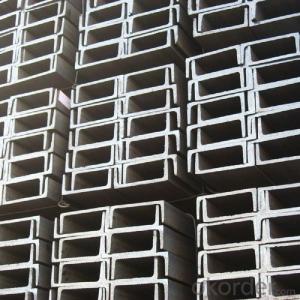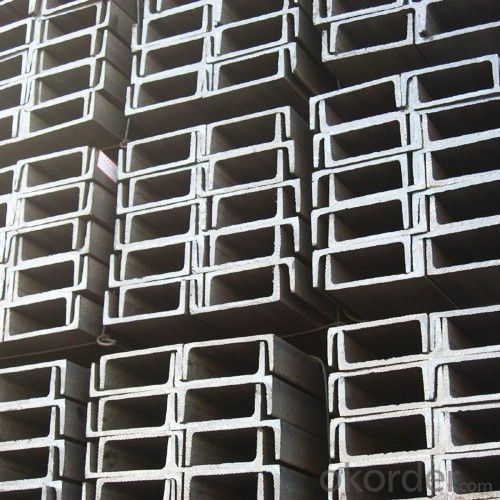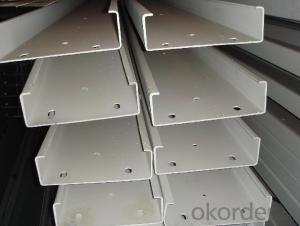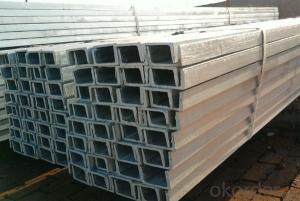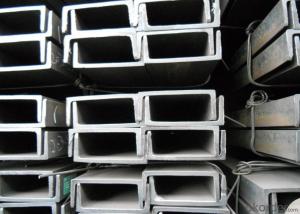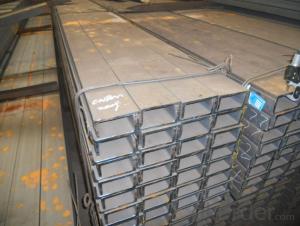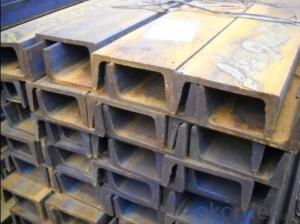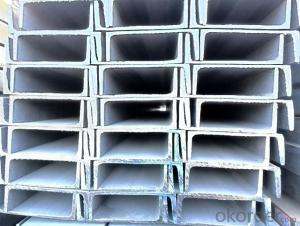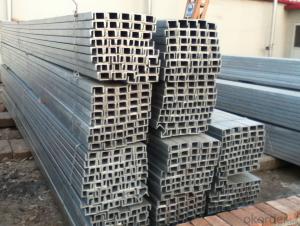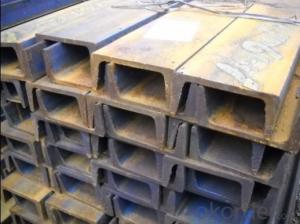100*50*6.0mm JIS U CHANNEL for CONSTRUCTION
- Loading Port:
- Tianjin
- Payment Terms:
- TT OR LC
- Min Order Qty:
- 25 m.t.
- Supply Capability:
- 10000 m.t./month
OKorder Service Pledge
OKorder Financial Service
You Might Also Like
Product Description:
Steel U Channel Details:
Minimum Order Quantity: 25 Tons Unit: m.t. Loading Port: Xingang Port
Supply Ability: 1000 Tons Per Day Payment Terms: TT or L/C
Product Description:
Specifications of Steel U Channel:
Standard Applied: GB Standard, EN Standard(UPN), JIS Standard
Sizes: 50mm to 300mm
Material Grade: Q235B, Q345B, S235JR, SS400, ASTM A36
As shown in the figure:
| JIS U CHANNEL | Standard h | Sectional b | Dimension s | t | Mass: Kg/m |
| (mm) | (mm) | (mm) | (mm) | ||
| 50x25 | 50 | 25 | 3.0 | 6.00 | 2.37 |
| 75X40 | 75 | 40 | 3.8 | 7.00 | 5.30 |
| 75X40 | 75 | 40 | 4.0 | 7.00 | 5.60 |
| 75X40 | 75 | 40 | 4.5 | 7.00 | 5.85 |
| 75X40 | 75 | 40 | 5.0 | 7.00 | 6.92 |
| 100X50 | 100 | 50 | 3.8 | 6.00 | 7.30 |
| 100X50 | 100 | 50 | 4.2 | 6.00 | 8.03 |
| 100X50 | 100 | 50 | 4.5 | 7.50 | 8.97 |
| 100X50 | 100 | 50 | 5.0 | 7.50 | 9.36 |
| 125X65 | 125 | 65 | 5.2 | 6.80 | 11.66 |
| 125X65 | 125 | 65 | 5.3 | 6.80 | 12.17 |
| 125X65 | 125 | 65 | 5.5 | 8.00 | 12.91 |
| 125X65 | 125 | 65 | 6.0 | 8.00 | 13.40 |
| 150x75 | 150 | 75 | 5.5 | 7.30 | 14.66 |
| 150x75 | 150 | 75 | 5.7 | 10.00 | 16.71 |
| 150x75 | 150 | 75 | 6.0 | 10.00 | 17.90 |
| 150x75 | 150 | 75 | 6.5 | 10.00 | 18.60 |
Usage/Application of Steel U Channel:
The steel u channel can be applied to construction of warehouses, workshops, sport stadiums and car parks etc. In details, the steel u channel belongs to carbon structural steel which is applied to in the field of construction and machinery. The steel u channel is usually used for arch-itechtural structure, and they could be welded in order to support or hang a vari-ety of facilities. They are also usually used in combination with I beam. Generally,the steel u channel must possess perfect welding property, riveting property and mechanical property and so on.
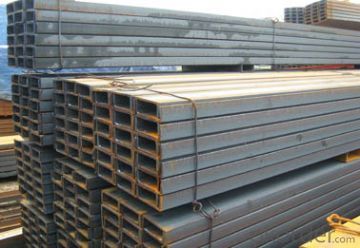
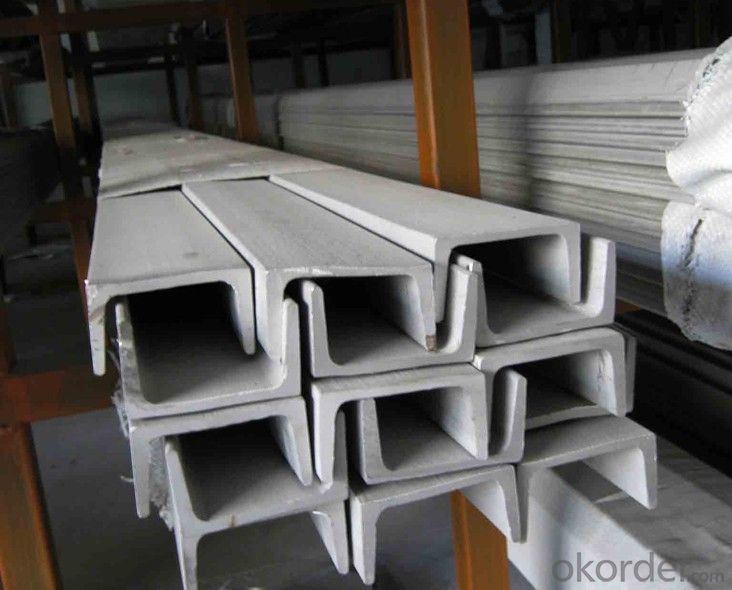
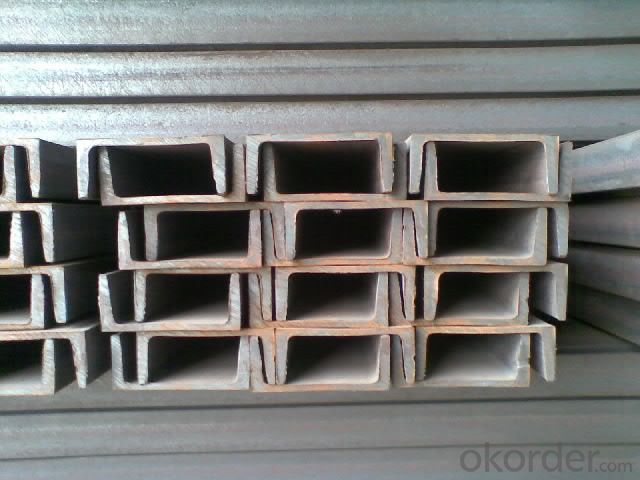
Package & Delivery: Steel U Channel
The steel u channel will be packed in bundle with steel wire at each end of every bundle and color marking in order to help the customer to recognize his goods more easily at sight.
And steel u channel could be loaded into 20ft or 40ft container, or by bulk cargo. If the weight of each bundle reaches less than 3.5 mt, the loading by break bulk cargo should be choosed. When the weight of each bundle reaches less than 3mt, the loading by container should be choosed.
As for the transportaion from mill to loading port, the truck will be usually used. And the maximum quantity for each truck is 40mt.
All in all, we could do in accordance with customer's request
- Q: How do steel channels perform in high-temperature environments?
- Steel channels perform well in high-temperature environments due to their excellent heat resistance properties. Steel is known for its high melting point and strength, allowing the channels to maintain their structural integrity even under extreme temperatures. Additionally, steel has low thermal expansion, minimizing the risk of warping or distortion. Overall, steel channels are a reliable choice for applications requiring stability and durability in high-temperature settings.
- Q: Are steel channels suitable for use in underground structures?
- Underground structures can benefit from the use of steel channels. These channels are frequently employed in construction due to their strength, durability, and versatility. When it comes to structures located underground, like tunnels or underground parking lots, steel channels offer several advantages. Firstly, steel channels possess a high load-bearing capacity. Robust support systems are typically necessary for underground structures to endure the pressure from surrounding soil or water. Steel channels are capable of evenly distributing the load, providing structural stability and preventing deformation or collapse. Secondly, steel channels are resistant to corrosion, which is particularly crucial in underground environments where moisture and high humidity levels are prevalent. Corrosion can weaken the structural integrity of materials, but steel channels coated with protective substances or constructed from stainless steel can withstand the harsh underground conditions. Additionally, steel channels can be easily fabricated and adjusted to meet specific design requirements, making them ideal for complex underground structures. They can be cut, welded, and shaped to fit various architectural needs, ensuring efficient installation and customization. Lastly, steel channels have a long lifespan and require minimal maintenance, reducing the overall cost and effort associated with underground structures. The durability of steel channels ensures that underground construction remains intact for an extended period, minimizing the need for repairs or replacements. In conclusion, steel channels are a suitable option for use in underground structures due to their strength, corrosion resistance, adaptability, and durability. These qualities make them an excellent choice for providing structural support and ensuring the longevity of underground constructions.
- Q: Can steel channels be used in the chemical industry?
- Indeed, the chemical industry finds steel channels to be highly applicable. With their remarkable strength, durability, and corrosion resistance, steel channels are frequently utilized across multiple industries, including the chemical sector. They serve as essential elements for structural support, while also being instrumental in constructing platforms, walkways, and equipment supports within chemical plants. Furthermore, steel channels exhibit exceptional resilience to both high temperatures and pressures, rendering them ideal for chemical processing and transportation. In summary, steel channels prove themselves to be an adaptable and dependable option for the chemical industry.
- Q: What are the different loadings that steel channels can withstand?
- Steel channels can withstand various loadings, including static loads, dynamic loads, and impact loads. The specific load capacity depends on factors such as the size, shape, and material grade of the steel channel. The loadings can range from lighter loads, such as those experienced in residential construction, to heavier loads in industrial or commercial applications. It is important to consider engineering specifications and safety codes to determine the appropriate loadings for steel channels in different applications.
- Q: Overhanging Scaffold; channel spacing
- Placement of the cantilever beam, welding rod base, since the corner in order to both sides of the bottom vertical pole, bottom and vertical sweeping bar buckle is fixed, installed in the horizontal sweep shot, and is fixed with a vertical rod, each side up 3--4 pole, then installed the first step (longitudinal flat bar and the vertical and lateral buckling) fixed flat bar (a small bar, near the pole and longitudinal vertical rod fastening fixed). To correct the vertical and horizontal lever of the upright pole to meet the requirements, tighten the fastening bolts according to the 45--55N & M force to form the initial section of the frame, and then extend forward in accordance with the above requirements until the first step of the rack is completed. After crossing the circle, the quality of the structure shall be thoroughly checked, and the design requirements and the quality of the frame shall be strictly ensured. The end wall parts shall be provided, and the second and third steps shall be erected according to the operation procedures and requirements of the first step...... In accordance with the erection process and the fashion set, the wall piece and the scissors support are provided with a work layer, a cross bar, a foot board and a work layer railing, a foot blocking board and a close mesh net.
- Q: What are the different types of steel channel connections for mezzanine floors?
- For mezzanine floors, various steel channel connections are commonly utilized to ensure stability and support for the structure, enabling it to bear the required load. 1. Bolted Connections: Among the most frequently employed steel channel connections in mezzanine floors are bolted connections. These connections involve the utilization of bolts and nuts to join the steel channels together. Bolted connections offer strength and the convenience of easy disassembly and reassembly if necessary. 2. Welded Connections: Welded connections involve welding to join the steel channels together. This connection type provides exceptional strength and rigidity. Welded connections are permanent and not easily disassembled, making them suitable for permanent mezzanine floor structures. 3. Clip Connections: Clip connections are another favored type of steel channel connection for mezzanine floors. These connections utilize clips that securely attach to the steel channels, providing a secure and easy installation. Clip connections are versatile and easily adjustable or modified as needed. 4. Slip-Fit Connections: Slip-fit connections involve inserting one steel channel into another, creating a tight and secure fit. These connections are commonly used when adjustability or expandability is required for the mezzanine floor. Slip-fit connections are simple to install and can be disassembled and reassembled if necessary. 5. Gusset Plate Connections: Gusset plate connections utilize additional steel plates, called gusset plates, to connect the steel channels together. These plates are typically welded or bolted to the steel channels, enhancing the connection's strength and stability. Gusset plate connections are frequently employed in heavy-duty mezzanine floor applications. It is important to consider factors such as load requirements, structural design, and installation preferences when selecting the appropriate steel channel connection for a mezzanine floor. Consulting a structural engineer or professional contractor is advisable to determine the most suitable type of steel channel connection for a specific mezzanine floor project.
- Q: Classification, use and material of channel steel
- Channel steel is divided into ordinary channel steel and light channel steel. Standard Specification for hot-rolled plain channel steel is 5-40#. Specifications for hot rolled flexible channel steel supplied by supply and demand agreement are 6.5-30#.
- Q: Can steel channels be used for creating support structures for ventilation systems?
- Support structures for ventilation systems can be created using steel channels. These channels are widely used in construction and engineering because of their durability and strength. They offer a solid framework for supporting the weight of ventilation equipment, including fans, filters, and ductwork. Moreover, steel channels provide design flexibility and can be tailored to meet specific project needs. Furthermore, steel is resistant to corrosion and can withstand harsh environmental conditions, making it suitable for use in moisture or chemical-exposed ventilation systems. Ultimately, steel channels are a dependable option for establishing support structures that guarantee the secure and effective functioning of ventilation systems.
- Q: How do steel channels contribute to the stability of a structure during high winds?
- Steel channels contribute to the stability of a structure during high winds by providing additional support and reinforcement. They are typically used in the construction of frames and beams, helping to distribute the wind load evenly throughout the structure. The channels help to prevent excessive deflection or deformation, ensuring that the structure remains stable and less susceptible to wind-induced forces.
- Q: How do steel channels contribute to sound insulation in buildings?
- There are several ways in which sound insulation in buildings can be enhanced by steel channels. Initially, one can utilize steel channels to establish a resilient channel system. This involves fastening the channels to the wall or ceiling studs and subsequently attaching the drywall to the channels rather than directly to the studs. This configuration creates a space between the drywall and the studs, effectively diminishing the transmission of sound vibrations from one side of the wall to the other. Moreover, steel channels can be employed to construct sound isolation walls or partitions. By incorporating multiple layers of drywall with steel channels interspersed, the channels aid in absorbing and dispersing sound energy. This technique significantly reduces the transfer of sound from one room to another, thereby fostering a more tranquil and comfortable environment. Additionally, steel channels can provide support for acoustical insulation materials. By filling the cavity between the steel channels with substances like mineral wool or fiberglass, the channels assist in absorbing sound and minimizing its transmission. This combination of steel channels and insulation materials fosters a more effective sound barrier, ultimately improving the overall sound insulation within the building. In essence, steel channels are vital components in bolstering sound insulation in buildings. They offer structural support for resilient channel systems, facilitate the construction of sound isolation walls, and provide a foundation for acoustical insulation materials. By employing steel channels in these various applications, the transmission of sound vibrations can be significantly reduced, resulting in a quieter and more serene indoor environment.
Send your message to us
100*50*6.0mm JIS U CHANNEL for CONSTRUCTION
- Loading Port:
- Tianjin
- Payment Terms:
- TT OR LC
- Min Order Qty:
- 25 m.t.
- Supply Capability:
- 10000 m.t./month
OKorder Service Pledge
OKorder Financial Service
Similar products
Hot products
Hot Searches
Related keywords
